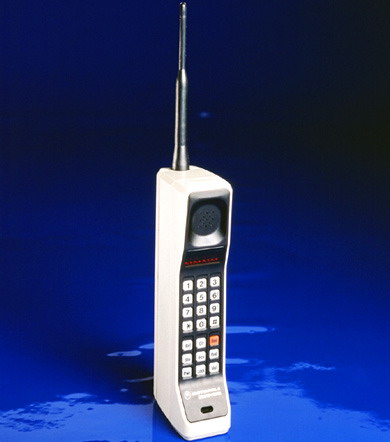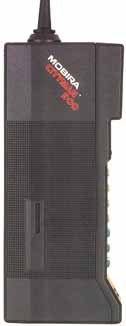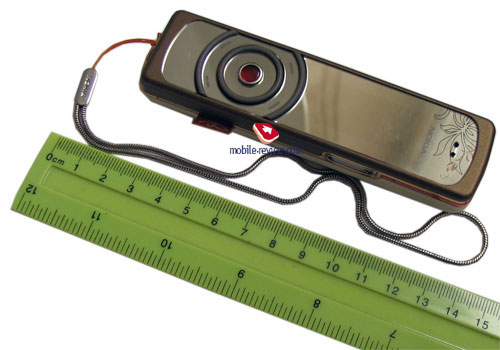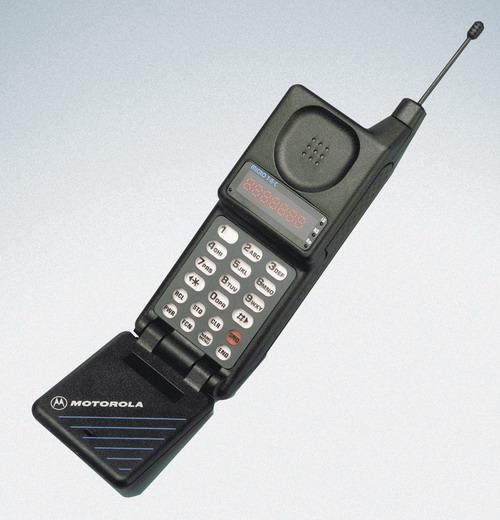At the very beginning of the way, mobile phones shared one form and type, and the available range of models could hardly blow someone away. The first mobile devices were more like a brick, neither more nor less, albeit they marginally won in weight. The zero point was 1973, when Motorola’s first device saw release – its creator was Dr. Martin Cooper. In his interview to CNN, Dr. Cooper said that the first handset was a brick-esque device, weighing in at 29 ounces (0.82 kg, though in fact the first prototype was one kilogram heavy). The very idea of a cellular phone had looked like something out of this world until the late 60-ies, and first came to Dr. Cooper’s mind when he was watching Start Trek, where people were able to communicate wirelessly. This movie anticipated not only the entire mobile communicator, but also a handful of other devices, some of which haven’t materialized as yet and still wait for their inventors. In the late 60-ies Start Trek was a huge even in the television world, undeniably a cult movie. Maybe, if hadn’t made it to the TV screens across the globe, the mobile phone would have come to life much later.

In the late 60-ies the market was dominated by car communication system, the demand for them was confined solely to government, taxi, army and so on. Back then, it was nowhere near the status of a commodity among common consumers. The idea of a “mobile phone” seemed utopia to people – they didn’t have the previous experience of managing such devices, and the frequency range was jam-packed with various companies.
The head of the development department of Bell Labs, Joel Engel, the company which was Motorola’s direct rival back then, predicted a complete failure for portable phones. And this doesn’t prove narrowness of his mind, the fact is, there weren’t any examples out there that would have indicated completely opposite things. Adding oil to the fire is the fact that one of Bell’s prototypes, demonstrating the benefits of a number pad was bearing striking resemblance to the today’s handsets.

A similar example is usually quoted in the computer-related literature, here are the words of Tomas Watson, in 1943 – the head of IBM: “I think there is a world market for maybe five computers”. The resemblance is so evident, that can easily make one wonder. IBM’s business was basing on production of calculating machines, rather than computers alone. The market for the first-generation computers was indeed small, but with the development of technology, the devices were getting more petite, less expensive, while their capabilities were improving. The same held true for the mobile phone market.
It is newsworthy that in 1994, Joel Engel was awarded a National Medal of Technology for fundamental contribution to the theory, design and development of the cellular communication systems. And this is an irony of fate, showing how a good developer missed the “gold mine”, failed to recognize it when the time was right.
This is what the inventor of the mobile phone had to say: «To the rest of the world it was a fantasy. To me it was an objective». The process of development of the world’s first handset took several years and only by February, 1973 the sample was ready at last, it was named DynaTac, which meant DYNamic Adaptive Total Area Coverage. It’s remarkable that having proposed the concept of a mobile phone, Dr. Cooper insisted on adequate dimensions of the device, though the technological limitation of those times did not enable him to get the phone as small as that Star Trek’s heroes owned. Already in 1973, Martin Cooper said that with time, mobile phones were going to shrink in size by a wide margin, and the time has proven his point of view.
The man in charge of the first phone’s design was the Industrial design director in Motorola, Rudy Krolopp. Neither he, nor his team had any examples to follow. What is more, Martin had set very tight deadline: in 6 weeks the phone had to be fully operable for FCC demonstration. A few days later, during a supper in a next-door restaurant, they decided on the final design variant. Krolopp reminiscences: «We called it a shoe phone, because it sort of looked a little bit like a boot». But even the design they came up with, required them to put some efforts into chucking the electronics in. DynaTac measured 9x5x1.75 inches (22.8x12.7x4.45 cm), and weighted almost a kilo. At that, it could only make and receive calls, its cell lasted for 35 minutes and needed a 10-hour long charging session. For 1973, the device’s dimensions were revolutionary, actually it had all the makings of a portable or mobile – for comparison, a typical phone we have nowadays measures 10x4.4x1.5 cm.

The first DynaTac-powered call took place on April, 3 of 1973 in New York, Dr. Cooper was in the street near Manhattan Hilton, and the base station was placed on the roof of Burlington Consolidator Tower (Alliance Capital Building today). And at the moment of his triumph, Dr. Cooper called… Joel Engel. Their conversation was roughly as follows: “Hi Joel – guess where I'm calling from?' Joel, I'm calling you from a 'real' cellular telephone. A portable handheld telephone”.
In April of 1973, Motorola release the jinnee from the bottle. In the next 10 years prior to the launch of the first commercial cellular network, Motorola was making great efforts to build up the infrastructure of cellular communication and enhance the first mobile phone. Almost in ten years’ time, until 1983, they created 5 prototypes of DynaTac, every successor in this line, thanks to the engineers, was smaller and lighter, yet packed the same features. In the end, they managed to achieve almost a half of the initial weight – all the way down from 1 kg to 450 grams.
Unlike the team of designers, common consumers instantly nicknamed this offspring “The Brick”, rather than a “Shoe”. In 1983, the DynaTac’s price was 3995 USD. Naturally, this made the cellular phone a luxury item, or indicator of high status in company, in other words allowed only the elite to have it. This audience has always been free-tongued, and this nickname “The Brick” became part of the history. Studying the example of DynaTac we can learn about the major trends that hold true for mobile phones even today.
- The device is designed without respect to the resource base; engineers have to fit certain components into given space, trying to figure out the compromise solution.
- Original phone’s name, which it received from the designers, didn’t manage to settle in people’s mind, everyone knows it as “The Brick”. It is a quite rare occasion when makers come up with product names that reflect their essence in a precise fashion, a great example of the opposite – the RAZR from Motorola.
- The first-of-a-kind device is copied by other manufacturers to a greater or lesser extent, as it sets the pace on the market.
In 10 years Motorola invested around 100 million dollars into creation of a cellular phone. The events of those long-gone times have been interwoven with rumors, and today the Web offers a reprint, which says literally the following.
Paul Galvin, the founder of Motorola, asked his old friend George Bush, who was the vice-president of the United Stats back then, take his 7-year-old grandson on a tour of the White House. All this was taking place against the backdrop of the FCC’s struggle against certification of the mobile phone. Galvin spent some time on preparing for the visit and took the mobile phone along with him. Bush hadn’t seen the device ever before and Galvin offered him to call his wife with it and so he did. Then they had an audience with Ronald Regan, the president of the US at that time, later in the evening of the same day, FCC had the instruction that came directly from the president to speed up the certification process.
Here is a snippet taken from the original text:
"Maybe the things were not moving if the US president wouldn't have said his word. This happened because of personal relationships of Motorola's founder Paul Galvin. One day he called his old fellow Vice-president George Bush to the White House and asked if he could show the White House to his 7 year old grandson. Motorola's founder told only after 30 years, what happened during the meeting with George Bush. P. Galvin showed mobile phone that he brought to the vice-president and told that his company got the license to deploy testing cellular network. FCC saw this device and almost approved it, but now is paying almost no attention to it.
According to Paul Galvin, Vice-president Bush didn't use a mobile phone before. "Why should you not call to Barbara?" Galvin offered. G. Bush called his wife and asked: "Do you know what I'm doing now? I'm talking on a mobile phone". Then he asked Paul: "Has Ron seen it?" Galvin realized that Bush was talking about the president Ronald Reagan and said "No".
The same day Galvin and other business-men were invited to meet the president Ronald Reagan. George Bush asked Paul Galvin to come closer to the President and said: "Ron, you should see this thing". Galvin explained that this was a mobile phone that should appear in the market soon. Reagan called someone and asked: "What's the status of this device?" Galvin said that company was ready to start selling it for about four years, but FCC hasn't allowed doing this, because maybe they wanted that the Japanese were the first who entered the market. Reagan said to his assistant: "Call the FCC's president and tell him that I want this device to be released".
The main problem here, though, is a great many of logical omissions, that an unsophisticated reader is unlikely to spot. “30 years later” is a long while, but for an article issued in 2003, this means that Regan was the president in 1973. But his time came only in 1981. Another flagrant contradiction is presence of one of Motorola’s founders, who had died on November, 5 in 1959 and physically could not tell the world about the “meeting” that took place much later. With some foul journalist’s commitment, the world saw the story where creation of the first mobile phone went on not without interference from the US government. Maybe, it was the case, however there are is no solid evidences or proof of that – if you happen to have some, we would be really happy to take a look at them, thank you in advance.
At long last, on September, 21 of 1983, Motorola got FCC’s approval for model Motorola DynaTac 8000X. This device became the world’s first commercial mobile phone. And it was the first page in the handset design book – the market was overtaken by candy bars. Initially they were dubbed as “block”, but then everyone like the “candy bar”.
Candy bar – a phone housed in conventional rectangular form-factor without any moving parts. These devices might have a sliding antenna, but other moving parts are missing. One of the most popular forms of mobile phones, being the most widely spread shape.

The very story how the “candy bar” term emerged is quite interesting – I haven’t managed to find a clear explanation of its origin, so I’m offering you my own vision. First cellular phones were, to a greater or lesser extent, copycats of the DynaTac and had rectangular form without rounded edges; for example, Nokia Mobira CityMan for NMT-networks, launched in 1987, shared these design cues.

In 1991 Nokia became the first company to start offering a cellular phone tailored for GSM networks, the prototype belonged to the 100-series. On hitting the shelves the model got the name – Nokia 1011 – and at the same time was the first device housed in the classical form-factor, yet with smoothened edges, looking a lot like a candy bar. The contrast between “candy bar” and “brick” marked the generations shift, advent of GSM and slow death of analog standards. It really doesn’t matter who came up with that “candy bar” first – consumers or Nokia’s staff, but this word has taken root and got to identify a whole segment of the mobile phone market. If you, by any chance, have a different version of how this happened, or know for sure when and where the story started – please, write a letter to me.


The Japanese market first saw a commercial mobile network in 1979, which was brought by NTT Public Corporation. But their particular network was meant for in-case use, so the handsets were by no means portable. Sometimes people get deluded by the paradigm that since the first network was established in Japan, then that would be the mobile phone’s homeland. It is by no means so – Japan got its first portable phone only in 1985, which was a variation of the in-car device placed in small box with a shoulder strap. Obviously, they started to call it a «shoulder phone». It weighted about 3 kilograms, so it wasn’t really a mobile device. The success came to cellular phones in Japan with the debut of light handsets by NTT in 1991, whose weight was around 220 grams. These devices are normally attributed to the first generation.
Stick or the magic wand
The candy bar form-factor has become the classic and it was deemed an impossible task to make it look different. However in September of 2004, Nokia proved the world wrong, as by releasing the Nokia 7280, the maker has created a small-numbered class of devices that are usually called Stick. At a glance, it is the same candy bar, yet tall and narrow with square section. Nokia 7280 had no keypad, which made the handset even more off-beat. From the position of ergonomics, these solutions are not very gratifying, as a result they don’t set off to conquer the market and act rather as fashion phones.

In October, 2005 they announced the Nokia 7380 which was the Nokia 7280’s inheritor form-factor wise, yet sported different filling. What was something of a novelty on debut, looked like nothing out of the ordinary next time. Nokia 7380 had no remarkable sales at all and didn’t take long to disappear from the market. Consumers preferred the first edition of the handset.

Similarly styled yet coming with two-column number pads solutions were released by Haier. In 2003 it opened up the range with the Haier P5, which was called a voice recorder like device by many, while the vendor positioned it as the PenPhone, underscoring its petite dimensions and resemblance to a pen. Technically, the Haier P5 may be well considered the forefather of the Stick form-factor, but low popularity of this solution made it a stranger among other offerings, consumers simply were not aware of it.

Flip – small addition to a candy-bar
The next step on the handset design front was the debut of flip, a tiny lid that covered the keypad preventing accidental presses in bags. Many are mistaken that Motorola came up with the whole flip concept first. This historical delusion is due to Motorola’s being the company that started on this style, and other companies began copying this novelty, but the flip in fact came from the revolutionary development of GTE corporation for wired phones. Again, we should thank Bell for the flip-armed phones, as in opposition to its domination over the US market, the competition designed a number of products, and the one with flip was among those.
In early 80-ies, all landline in the US were the property of the operators, so were the devices, though. The consumers were not buying phones, but taking them on lease from an operator, and thus didn’t have the device at their disposal. For every device the user had to pay a certain sum of money on monthly basis – not quite convenient scenario, if were look at it today, don’t you think?!
GTE corporation kept mum on development of a product line, which was called make-it-or-break-it, and the centerpiece there was the device with an attached flip. What was so revolutionary about this offering? It shapechanged the concept, allowing the user to buy an inexpensive device and do away with monthly pay-outs once and for all. Over at GTE they knew that having put in solutions no different from already existing devices, they wouldn’t make the consumers go for them, and thus they needed innovative products badly.
Flip Phone – is the first commercial device with plastic lid covering up the number pad, made by GTE. It was connected to the landline via RJ11 socket. Also, this wired handset had other perks. The flip was made active, so that by opening it you performed the same action as if you picked up the receiver, and by shutting the flip, you could “hang up” and end the call. The benefits for the user were evident – he could throw the device anywhere without caring about accidental pick-ups, as flip was very unlikely to fold open on its own.

Flip – a folding cover on a candy bar-styled phone, which may be active (picks/hangs up) or passive. The market has seen many flip phones, but in the end those with bottom-hinged flip have come to dominate. But there were also a handful of models, where flip was upward-acting, in 2004-2005 pseudoclamshells were housed exactly in this form-factor. The leadership in creation of such phones belongs to Samsung, however back then it called them Flip Phone (2000, the US market).
It doesn’t take a degree to figure out that GTE protected its innovation with a patent that was in effect until 1993, when the flip’s inventor had no more need in it. The wired handset didn’t become a sought-after product, while the word “flip” was firmly linked to mobile communications and Motorola’s products in particular.
This was also assisted by the debut of Motorola DPC650, the first flip-equipped device, which was the flagship of the MicroTAC range. It might be a real challenge to image, though back in 1989 it was the most diminutive handset. Soon enough the manufacturers came to realize that expansion of their line-ups can be carried out by releasing two editions of phones – with and without bundled flip. While Motorola initially wasn’t carried away by this, other makers were very aggressive. Such variations became par for the course for Ericsson, what is more, devices coming with flip were positioned as top solutions, fashion-conscious phones.

The golden times of flip-armed models fell on the mid 90-ies, when all companies were proposing such solutions. And the demand for these handsets was on the rise, with Motorola being the trend-setter once again. Over at the company they had strong understanding that their positions on the market had to be secured and in March, 1994 filed an inquiry to patent office in order to get the exclusive rights for the “Flip Phone” brand. Patent #2157939 was registered in 1998, when it was practically of no real use. It was in effect until 2005, when the company gave it up. However, in 1995 Motorola even had to vindicate the “flip” term, prohibit its usage by accessory makers, since, as the company’s authorities supposed, this word could be associated only with Motorola’s handset. Haltof Product Design Inc was one of the parties involved, you can learn more about the case here.
The example of flip allows us to investigate, for how long a solution can stay on the peak – the flip was in for about 10 years. The twilight and its last goodbye to the market would be the arrival of the Ericsson T10s, Ericsson T18s. Both phones had flips onboard, were identical software-wise, although sported different designs, and on top of that the senior model boasted an active flip. By the way, this is all another way to position devices differently. Why the launch of these two is the end of flip’s history?

It is simple, Motorola marked the end itself with the release of the first clamshell, the StarTac. Starting from 1996 users had been hotly debating on the attractions of the new product (new form-factor, dimensions, features), which led to the following conclusion. The flip found in the StartTac is full-fledged, for it comprises the display, making for overall smaller size. Following from the comparison with the StarTac, the flip-armed models were even called semi-clamshell, yet people didn’t really like it and this term had a very short lifespan. In the US market, where Motorola has always occupied a substantial share, the “flip” has morphed into the word for identifying clamshells, the handsets whose top part can be unfolded. Nonetheless in Europe and Asia, by “flip” they still mean the lid on a candy bar-styled handset and rarely use it for clamshells.
Related links:
Eldar Murtazin ([email protected])
Translated by Oleg Kononosov ([email protected])
Published — 21 May 2006
Have something to add?! Write us... [email protected]













